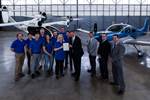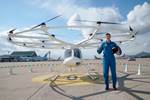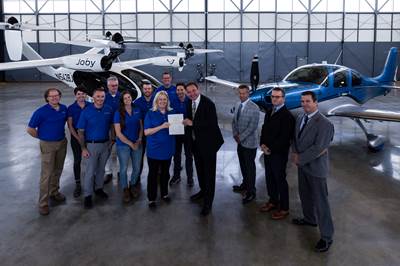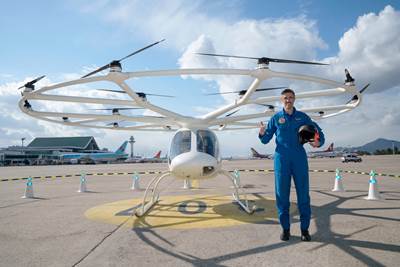VoloConnect four-seater aircraft takes first flight
Volocopter eVTOL prototype configuration makes first flight after only 17 months in the making, continues to target 2026 entry into service.
VoloConnect. Photo Credit: Volocopter GmbH
On June 7 at the UP.Summit, an annual gathering of leaders in transportation innovation hosted by investment firm, (Santa Monica, Calif., U.S.), urban air mobility (UAM) company, (Bruchsal, Germany), announced that it achieved the first flight of its fixed-winged passenger aircraft, the , in May 2022. This electric vertical takeoff and landing (eVTOL) aircraft is one of a fleet of distinct configurations undergoing flight tests for the company.
“Having a whole family of electric aircraft in the test flight phase is a pioneering feat,” Florian Reuter, Volocopter CEO, says. “Volocopter’s leadership in the industry stems from announcing plans and then delivering on them visibly with public test flights. Our technology platform is the foundation for our family of aircraft approach and has proven to deliver results at an astounding speed.”
Volocopter’s third product solution, the VoloConnect, is reported to offer further and faster journeys than any other Volocopter aircraft to date, with a range of more than 60 miles (96.5 kilometers), and flight speeds above 155 miles per hour. An extended range and higher payload will enable its use beyond city centers on routes like Burbank to Huntington Beach in Los Angeles, Calif., U.S. With the composite VoloCity and VoloConnect air taxi designs fulfilling demands for metropolitan flights and suburban connections in densely populated regions respectively, Volocopter believes it is ready to serve a broader range of passengers’ flight needs. Moreover, the VoloConnect is targeting a 2026 entry into service, while the VoloCity is targeting commercial launch in 2024.
A dedicated team in Munich, led by Sebastian Mores, chief engineer, VoloConnect, is responsible for bringing the VoloConnect prototype to life. “This is an extraordinary moment for us — seeing the VoloConnect soar to the sky marks the achievement of one of our key milestones and demonstrates just what we are capable of in a short time and in line with the company’s overall strategy for crewed and uncrewed aircraft. Furthermore, new technologies will be tested that will gradually be implemented during the overall program development,” Mores says.
Volocopter says it designed the VoloConnect and its other eVTOL aircraft to meet the highest aviation safety standards according to European Aviation Safety Agency (EASA, Cologne, Germany). The prototype completed its first flight in May 2022 after just 17 months in the making and performed a few maneuvers for two minutes and 14 seconds during its first flight. The prototype has all the planned aerodynamics and performance features of the future commercial product.
The VoloConnect is a lift-and-cruise aircraft, with six rotors facilitating vertical takeoff, while two electric fans, in combination with uplift-creating wings, ensure high forward speeds. The VoloConnect prototype is currently being put through a demanding series of flight tests to verify that the aircraft and its systems are in line with the performance limits and prepared for the subsequent development steps. This phase encompasses a raft of different tests, Volocopter says, including standardized low-speed, transition, high-speed and engine failure testing for automated and later autonomous flights — all standard-issue tests for an eVTOL passenger aircraft manufacturer. Within the first three test flights of this campaign, the team was able to verify a significant portion of the eVTOL’s envelope with forward speeds up to 40 miles per hour and 28 miles per hour sideward flight speeds during tests. The test flight envelope will be gradually opened as part of the test flight campaign over the coming weeks.
For future services, Volocopter also intends to fully integrate all three of its aircraft configurations into individualized UAM ecosystems for cities and use its to unite all of the company’s flight operations, passenger services, maintenance and more for a seamless mobility experience.
Related Content
Airbus puts a pause on CityAirbus NextGen eVTOL program
Airbus Helicopters is hitting the breaks on program progress, citing that battery technologies need to evolve before it can launch a successful UAM program.
Read MoreJoby flies two eVTOL aircraft simultaneously in testing milestone
The latest in the company’s flight testing program targets certification testing acceleration and support of its passenger-carrying goals by 2026.
Read MoreArcher completes construction of high-volume manufacturing facility for Midnight eVTOL aircraft
Tooling load-in is already underway ahead of the planned start of initial production beginning early 2025, while Stellantis and Archer work to finalize the exclusive contract agreement.
Read MoreJoby demonstrator makes 523-mile hydrogen-electric flight
Hydrogen-electric program builds on technology developed by H2FLY subsidiary, demonstrates potential for emissions-free regional travel using Joby’s all-composite eVTOL aircraft.
Read MoreRead Next
Joby receives Part 135 Certification from the FAA ahead of schedule
The certification, initially targeted for the second half of 2022, is another step toward commercial operation. Joby will use conventional aircraft to refine systems and procedures in advance of launching eVTOL service targeted for 2024.
Read MoreVolocopter conducts first crewed eVTOL test flight in South Korea
Five-minute crewed and public test flight of the Volocopter 2X demonstrates South Korea’s goal to achieve UAM commercialization by 2025.
Read MoreScaling up, optimizing the flax fiber composite camper
Greenlander’s Sherpa RV cab, which is largely constructed from flax fiber/bio-epoxy sandwich panels, nears commercial production readiness and next-generation scale-up.
Read More












